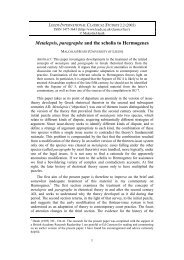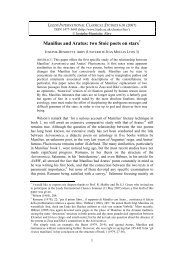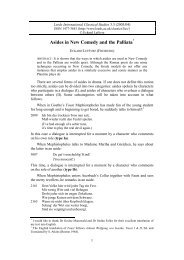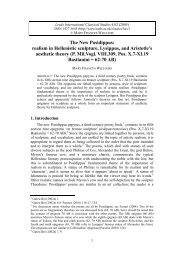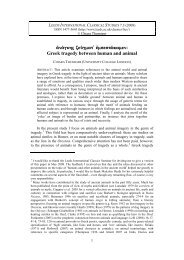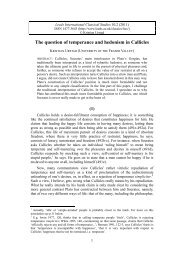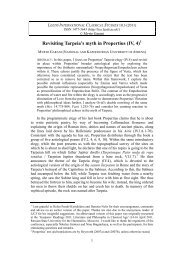Teiresias, the seer of Oedipus the King - Leeds International ...
Teiresias, the seer of Oedipus the King - Leeds International ...
Teiresias, the seer of Oedipus the King - Leeds International ...
You also want an ePaper? Increase the reach of your titles
YUMPU automatically turns print PDFs into web optimized ePapers that Google loves.
HANNA M. ROISMAN, TEIRESIAS, THE SEER OF OEDIPUS THE KING<br />
plot facilitator and <strong>Oedipus</strong>’s sparring partner, he could not have fulfilled <strong>the</strong><br />
<strong>seer</strong>’s role in focusing so well <strong>the</strong> doubts about knowledge that <strong>the</strong> play raises.<br />
2. Seneca’s <strong>Teiresias</strong><br />
Seneca adopted various aspects <strong>of</strong> Sophocles’ plot, which I will not go into<br />
here; but he was quite independent in his characterization. 22 His <strong>Oedipus</strong>, to take<br />
<strong>the</strong> chief example, is a more introspective character than Sophocles’ hero and<br />
expresses premonitions and a sense <strong>of</strong> guilt that his Sophoclean namesake did not.<br />
His <strong>Oedipus</strong> also places greater emphasis than <strong>the</strong> Sophoclean hero on his courage<br />
in having killed <strong>the</strong> Sphinx, and less on his capacity to know, though he mentions<br />
that too.<br />
The same independence applies to Seneca’s treatment <strong>of</strong> <strong>Teiresias</strong>. Seneca<br />
inherited <strong>Teiresias</strong> as a character in <strong>the</strong> <strong>Oedipus</strong> saga from Sophocles, but very<br />
much reduced his role and his presence. He places <strong>Teiresias</strong> on stage for only 46<br />
lines, in contrast to <strong>the</strong> 76 lines <strong>of</strong> Sophocles’ <strong>Teiresias</strong>. He also shifts key<br />
functions that Sophocles had given to <strong>Teiresias</strong> to Creon, making Creon <strong>the</strong> one<br />
who argues with <strong>Oedipus</strong> to create dramatic tension and who informs <strong>Oedipus</strong><br />
that he was Laius’ murderer. Moreover, Seneca makes his <strong>Teiresias</strong> not only a less<br />
contentious presence than Sophocles’ <strong>seer</strong>, but much less a presence altoge<strong>the</strong>r.<br />
Seneca’s <strong>Teiresias</strong> is an ancillary figure who interacts minimally with <strong>the</strong><br />
o<strong>the</strong>r characters in <strong>the</strong> play. There is no real give and take between him and<br />
<strong>Oedipus</strong>, or between him and any o<strong>the</strong>r character in <strong>the</strong> play. In <strong>the</strong> divination<br />
rites over which he presides, he takes second place to his daughter Manto, who is<br />
<strong>the</strong> one to perform <strong>the</strong>m. He ushers in <strong>the</strong> choral paean to Bacchus, but does not<br />
participate in it. He figures in Creon’s account <strong>of</strong> <strong>the</strong>ir visit to <strong>the</strong> O<strong>the</strong>rworld; but<br />
<strong>the</strong> visit is not dramatized, so <strong>the</strong> audience does not see him summoning Laius’<br />
ghost or conversing with him.<br />
But this apparent reduction in role in no way means that Seneca stuck<br />
<strong>Teiresias</strong> in his play because he had to. He did not. He could have left him out,<br />
just as he had omitted <strong>the</strong> A<strong>the</strong>nian <strong>King</strong> Aigeus, who had appeared in Euripides’<br />
Medea, in his own rendition <strong>of</strong> <strong>the</strong> myth. It is also possible that he removed<br />
<strong>Teiresias</strong> and Menoeceus, who figured in Euripides’ Phoenician Women, from his<br />
version, though one cannot be sure here because only 600 lines <strong>of</strong> <strong>the</strong> play have<br />
come down to us.<br />
Seneca clearly chose to include <strong>Teiresias</strong> in his <strong>Oedipus</strong>. But why? I set about<br />
trying to answer this question by looking at his persona in much <strong>the</strong> same way as I<br />
had at <strong>the</strong> persona <strong>of</strong> Sophocles’ <strong>Teiresias</strong>, starting with his characterization and<br />
going on to his function. It soon became apparent, though, that <strong>the</strong> concept <strong>of</strong><br />
characterization is problematic here. Seneca does not really give his <strong>Teiresias</strong> a<br />
‘character’ or ‘personality’—that is, a set <strong>of</strong> traits or behaviors with an organic<br />
consistency and continuity. Ra<strong>the</strong>r, he presents his <strong>Teiresias</strong> in three distinct<br />
depictions, which are not connected to one ano<strong>the</strong>r in <strong>the</strong> way that various facets<br />
22 For <strong>the</strong> recent tendency to analyze Seneca’s tragedies independently <strong>of</strong> <strong>the</strong>ir Greek precursors,<br />
and <strong>the</strong> problem <strong>of</strong> <strong>the</strong> identity <strong>of</strong> Seneca <strong>the</strong> tragedian, see most recently Kohn (2003).<br />
12



